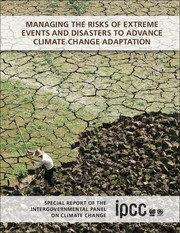 Managing the Risks of Extreme Events and Disasters to Advance Climate Change Adaptation
Managing the Risks of Extreme Events and Disasters to Advance Climate Change Adaptation Book contents
- Frontmatter
- Contents
- Section I
- Section II
- Section III
- Chapter 1 Climate Change: New Dimensions in Disaster Risk, Exposure, Vulnerability, and Resilience
- Chapter 2 Determinants of Risk: Exposure and Vulnerability
- Chapter 3 Changes in Climate Extremes and their Impacts on the Natural Physical Environment
- Chapter 4 Changes in Impacts of Climate Extremes: Human Systems and Ecosystems
- Chapter 5 Managing the Risks from Climate Extremes at the Local Level
- Chapter 6 National Systems for Managing the Risks from Climate Extremes and Disasters
- Chapter 7 Managing the Risks: International Level and Integration across Scales
- Chapter 8 Toward a Sustainable and Resilient Future
- Chapter 9 Case Studies
- Section IV
- Index
- References
Chapter 9 - Case Studies
from Section III
Published online by Cambridge University Press: 05 August 2012
- Frontmatter
- Contents
- Section I
- Section II
- Section III
- Chapter 1 Climate Change: New Dimensions in Disaster Risk, Exposure, Vulnerability, and Resilience
- Chapter 2 Determinants of Risk: Exposure and Vulnerability
- Chapter 3 Changes in Climate Extremes and their Impacts on the Natural Physical Environment
- Chapter 4 Changes in Impacts of Climate Extremes: Human Systems and Ecosystems
- Chapter 5 Managing the Risks from Climate Extremes at the Local Level
- Chapter 6 National Systems for Managing the Risks from Climate Extremes and Disasters
- Chapter 7 Managing the Risks: International Level and Integration across Scales
- Chapter 8 Toward a Sustainable and Resilient Future
- Chapter 9 Case Studies
- Section IV
- Index
- References
Summary
Executive Summary
Case studies contribute more focused analyses which, in the context of human loss and damage, demonstrate the effectiveness of response strategies and prevention measures and identify lessons about success in disaster risk reduction and climate change adaptation. The case studies were chosen to complement and be consistent with the information in the preceding chapters, and to demonstrate aspects of the key messages in the Summary for Policymakers and the Hyogo Framework for Action Priorities.
The case studies were grouped to examine types of extreme events, vulnerable regions, and methodological approaches. For the extreme event examples, the first two case studies pertain to events of extreme temperature with moisture deficiencies in Europe and Australia and their impacts including on health. These are followed by case studies on drought in Syria and dzud, cold-dry conditions in Mongolia. Tropical cyclones in Bangladesh, Myanmar, and Mesoamerica, and then floods in Mozambique are discussed in the context of community actions. The last of the extreme events case studies is about disastrous epidemic disease, using the case of cholera in Zimbabwe, as the example.
The case studies chosen to reflect vulnerable regions demonstrate how a changing climate provides significant concerns for people, societies, and their infrastructure. These are: Mumbai as an example of a coastal megacity; the Republic of the Marshall Islands, as an example of small island developing states with special challenges for adaptation; and Canada's northern regions as an example of cold climate vulnerabilities focusing on infrastructures.
- Type
- Chapter
- Information
- Managing the Risks of Extreme Events and Disasters to Advance Climate Change AdaptationSpecial Report of the Intergovernmental Panel on Climate Change, pp. 487 - 542Publisher: Cambridge University PressPrint publication year: 2012
References
- 13
- Cited by


